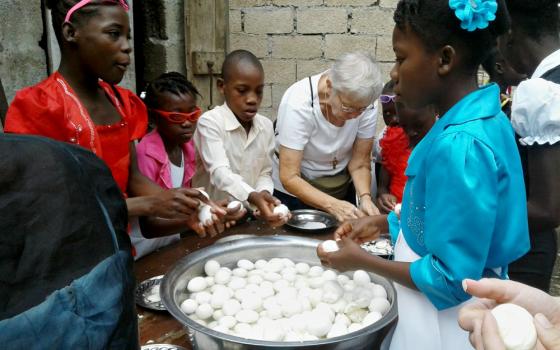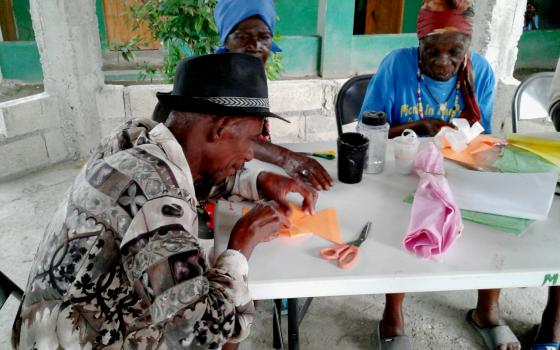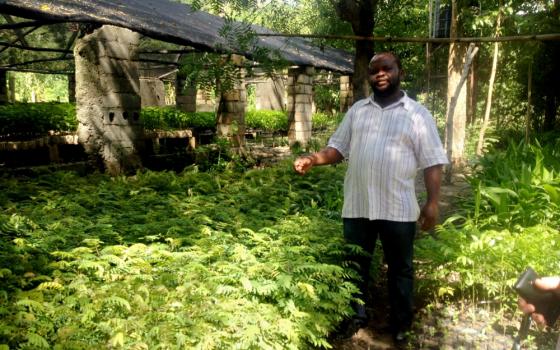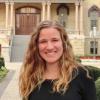Notes from the Field includes reports from young people volunteering in ministries of Catholic sisters. A partnership with Catholic Volunteer Network, the project began in the summer of 2015. This is our seventh round of bloggers: Viviana Garcia-Blanco is a Dominican Volunteer at the United Nations and Geri Lanham is a volunteer with the Religious of Jesus and Mary in Gros Morne, Haiti. This is Geri's first blog post. Read more about her here.
___
Haiti is literally and figuratively a land of mountains, a place of ups and downs.
It is a land of intense sorrow and incalculable joy: destruction from natural disasters and rebirth instigated by the unyielding spirit of independence of the Haitian people. It is a place that prides itself in giving an authentic welcome to visitors who become, as my dad would say, "ruined for life" in the best possible way, because the experiences they have in this country completely change how they see the world and leave an indelible mark on their hearts.
This is a place of imperfections, but it is also a place of beauty, not despite the poverty, but amid it as people strive every day to live with dignity. Haitians have an inexhaustible and inextinguishable joy in their hearts, which they share each time they pass someone on the street and offer a simple greeting to a stranger.
Dec. 15 marked the beginning of my third year in Haiti as a volunteer with the Religious of Jesus and Mary. Our home base is Gros Morne, a town 20 kilometers (about 12 miles) down a dirt road from Gonaïves, capital of the department of the Artibonite. Gros Morne, a town of 25,000 people, sits at the center of the arrondissement (county) of Gros Morne. The county boasts a total population of 150,000 between the eight rural communal sections and the main town of Gros Morne.
Thanks to my varied experiences during my time in Gros Morne, I have definitely become ruined for life in the best possible way: There are realities and feelings that will stay with me no matter where my next good steps may lead me. There is a Haitian proverb that translates to "Follow your heart," and this island and its people provide plenty of opportunities to do just that in a manner that is true to self and remembers where you came from and what shaped you.
Although Haiti is a small island nation, the area where you come from within the country makes a difference. People from different zones use slightly different language and customs, which act as a marker that tells others where exactly you come from in the country and thus define part of who you are.
People take pride in their homes and use the social connections of where they come from to build their social and economic capital. For example, if a young person from a certain zone in the countryside arrives in a suburb of the capital and finds job opportunities, he or she will invite others from home to join him or her so they can collectively work to live well where they are and send back money to their home community.
I come from a small town of 10,000 people surrounded by fields of corn and soy in central Illinois. Even though Charleston is a small place, it is famous to sandwich lovers as the home of the original Jimmy John's and to NFL fans as the home of Eastern Illinois University.
Charleston gave me a formation that provided me with an understanding of the world and my place in it. I first traveled to Haiti with my dad, a campus minister who leads immersion trips of students to Haiti. On these trips, I saw and experienced the work that the Religious of Jesus and Mary are doing in Gros Morne and decided I would like to somehow be part of their mission.
My studies at the University of Notre Dame expanded my horizons and deepened my desire to make a meaningful impact in the world. I had the good fortune to be able to take advantage of a Haitian Creole language course offered by Karen Richman, which gave me an invaluable foundational grasp of Haitian language and culture that continues to serve me well.
When I arrived in Gros Morne to serve alongside Sr. Patricia Dillon and Sr. Jacqueline Picard, my language background was a great gift that allowed me to jump into the projects led by my heart and my head. I spend my time collecting data and stories to highlight the impact of the various projects, and I write and translate reports that our local partners prepare for the groups that support them from around the world.
Sister Pat and Sister Jackie physically stand about 5-foot-nothing, but they have an impressive presence and sheer force of will that command a room and inspire a high level of respect. They remain dedicated to this community amid all of the frustrations and work tirelessly to help to improve and positively impact the quality of life for people in Gros Morne.
This year marks the 20th anniversary of the Religious of Jesus and Mary in Haiti, and during this time, the community in Gros Morne has developed and supported many projects, but the big three remain the Grepen Agronomy Center; the primary school, Lekòl Jezi-Mari; and the nursing home, Maison Bon Samaritain. Each of these project sites boasts local community partners who are passionate about the projects and have plans for how to advance them and make them durable for the future.
Their good energy and vision excites me and makes my task of sharing their story with donors and partners via reports and communications a joy that enhances my understanding of this place and its people based upon my experiences at these project sites.
Besides our core community of sisters and volunteers who live at our mission house, which is called Kay Jezi-Mari, in Gros Morne, we have a revolving door of visitors who come to rejuvenate and re-energize us and the various projects. It is a great privilege when I have the opportunity and the responsibility to walk with one of the visiting groups to translate their experience with our local partners. The visitors bring new insights and resources for the existing projects, and our local partners have the chance to share their desires and their frustrations with the groups who support them.
The five-member agronomy team of at the Grepen Agronomy Center teach local farmers and community leaders new techniques to increase the yields in their fields so they can better respond to the needs of their families. I never imagined that I would be translating for agronomy formations and learning about goat diarrhea, but it has proven to be practical knowledge for life in this rural community.
At Lekòl Jezi-Mari, the director, Mèt Leny, leads a team of 22 teachers who strive each day to form the leaders of tomorrow from kindergarten to sixth grade in a rural neighborhood zone of Gros Morne. And the four strong nursing staff at Maison Bon Samaritain work to provide a dignified quality of life for the 21 older and infirm residents at the center, some of the most vulnerable residents in this community.
It is an honor and a privilege that my life path continues to cross and be enriched by all of theirs as we walk this winding road together.
[Geri Lanham lives in community with the Religious of Jesus and Mary in Gros Morne, Haiti.]



